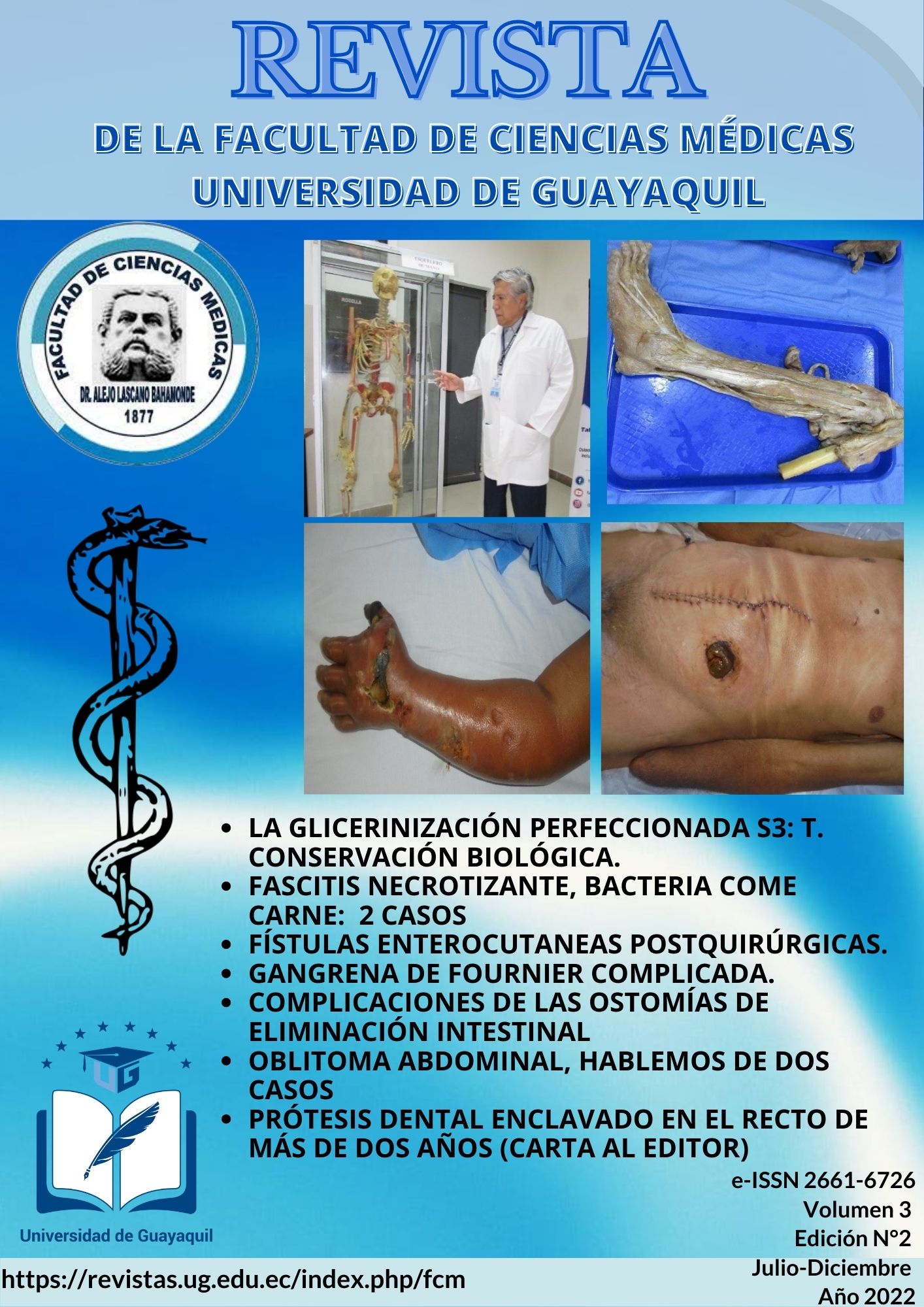Complicated Fournier's gangrene in a Third Level Hospital
Let's talk about four cases
Keywords:
Fournier gangrene, necrotizing perineal fascitisAbstract
It is a potentially fatal, sudden, progressive infectious process, of multibacterial etiology, but of low virulence (E.coli, Klebsiella, Proteus, Staphylococci, clostridium, bacteroides, fusobacterium, etc.) that causes affection of subcutaneous cellular tissue, fasciae and skin ( necrotizing fasciitis) of the perineal region and genitalia. It is rare but its condition increases in immunocompromised patients, diabetes (decreased phagocytosis and chimiotaxis), neoplasms, alcoholism, kidney failure, malnutrition, obesity, chronic corticosteroid therapy, where bacteria become very aggressive and destructive of tissues, reaching a causes systemic symptoms such as septic shock that compromises life.
The origin is usually a perianal abscess, anal fistulas, rectal injuries, hemorrhoids, or ligatures of hemorrhoids, pressure ulcers, episiotomy in women, bartholinitis, etc.
The present work included 4 cases for analysis. The average age of the patients was 56 years old (range 33-83 years), 4 patients had some personal pathological history. Among the risk factors presented was diabetes mellitus in all 4 patients; of these 1 with anal cancer undergoing chemotherapy, 1 with morbid obesity, hypertension with restrictive respiratory insufficiency, 1 with incarcerated inguino-scrotal hernia plus chronic renal failure and double amputation of lower extremities (inability to walk) and 1 with traumatic urethral rupture due to catheterization plus chronic renal failure and CVD with inability to walk.
References
Lisseth Camargo. Gangrena de Fournier: revisión de factores determinantes de mortalidad. Rev Chil Cir. 2016;68(3):273---277
Eliahu Laor. Outcome Prediction in Patients with Fournier's Gangrene. The Journal of Urology Volume 154, Issue 1, July 1995, Pages 89-92.
Robert Paty. Gangrene and Fournier's gangrene. Urologic Clinics of North America. Volume 19, Issue 1, February 1992, Pages 149- 162.
Marco Barquero Argüello. Las bases la gangrena de Fournier. Revista Medica de Costa Rica y Centroamerica LXXIII (619) 2016, 343 – 346.
Natasha Garcia Caldas. o uso da terapia a vácuo no tratamento da síndrome de fournier - revisão da literatura, experiência do serviço e série de caso ,Unidade de Cirurgia Geral, Brasílias. Relatos Casos Cir. 2019;5(3):e2229
Taygun Gülşen. Fournier’s Gangrene, case report. Turk J Colorectal Dis 2019;29:206-210
Selahattin Çalışkan. Fournier’s gangrene: Review of 36 cases. Ulus Travma Acil Cerrahi Derg, September 2019, Vol. 25, No. 5
Pedro Yulier Viel Sanchés. Gangrena de Fournier. Revista Cubana de Medicina Militar. 2020; 49(1):206-213
Carlos Eduardo Muñoz-Medina. Fournier gangrene: a case report. REV HISP CIENC SALUD. 2018; 3 (3)
Tatiana Vargas Rubio. Gangrena de Fournier: generalidades. Revista Médica Sinergia, Vol.4 Num: 6 - Junio 2019 pp: 100 – 107.
Sergey A. Chernyadyev. Fournier’s Gangrene: Literature Review and Clinical Cases. Urol Int 2018;101:91–97.
Lewis G, Majeed M, Olang C y cols. Fournier's Gangrene Diagnosis and Treatment: A Systematic Review. Cureus [Internet]. 2021;13(10). Disponible en: https://doi.org/10.7759/cureus.18948
Beecroft N, Jaeger C, Rose J y cols. Fournier's Gangrene in Females: Presentation and Management at a Tertiary Center. Urology [Internet]. 2021;151:113-7. Disponible en: https://doi.org/10.1016/j.urology.2020.05.056
Viel P, Despaigne R, Mourlot A y cols. Gangrena de Fournier. Rev Cuba Med Mil [Internet]. 2020;146(8):e47. Disponible en: https://www.scienceopen.com/document?vid=39097a46-ec9d-44ec-96b9-6746348523c3
Regalado J. Factores De Riesgo Asociados a Gangrena De Fournier. Rev la Fac Med Humana [Internet]. 2018;18(4). Disponible en: https://doi.org/10.25176/RFMH.v18.n4.173
Alarcón Salvador Juan Felipe. Experiencia y Revisión de la Literatura en el Manejo de la Gangrena de Fournier en un Hospital de Referencia en Ecuador, 2019-2020. Vol. 10 No. 1 Enero-Junio 2022 https://doi.org/10.54212/27068048.v10i1.129





